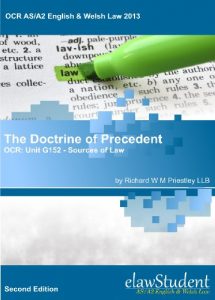THE DOCTRINE OF PRECEDENT
CHAPTER 1. Introduces the common law and then examines precedent and the doctrine of stare decisis in detail.
CHAPTER 2. Takes a comprehensive look at the court hierarchy; explains following, overruling, reversing, distinguishing and disapproving judgments with many case examples; examines the position of the Judicial Committee of the Privy Council; and the effect of European Union law and the Human Rights Act 1998.
CHAPTER 3. Lays out the comparative advantages and disadvantages of the doctrine and operation of precedent; ratio and obiter explained.
CHAPTER 4. Introduces equity and equitable maxims. This chapter is not strictly relevant to judicial precedent but is helpful in putting common law in context. Further, an understanding of equity is important even though it is not in the syllabus - though it should be!
NOTE The edited judgments of all cited cases in these chapters are laid out in an appendix.
CHAPTER 1. Introduces the common law and then examines precedent and the doctrine of stare decisis in detail.
CHAPTER 2. Takes a comprehensive look at the court hierarchy; explains following, overruling, reversing, distinguishing and disapproving judgments with many case examples; examines the position of the Judicial Committee of the Privy Council; and the effect of European Union law and the Human Rights Act 1998.
CHAPTER 3. Lays out the comparative advantages and disadvantages of the doctrine and operation of precedent; ratio and obiter explained.
CHAPTER 4. Introduces equity and equitable maxims. This chapter is not strictly relevant to judicial precedent but is helpful in putting common law in context. Further, an understanding of equity is important even though it is not in the syllabus - though it should be!
NOTE The edited judgments of all cited cases in these chapters are laid out in an appendix.






